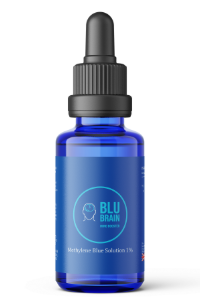Your basket is currently empty!

Methylene Blue offers significant therapeutic potential across multiple health domains.
This synthetic compound demonstrates promising neuroprotective properties, enhancing mitochondrial function and cognitive performance through improved cellular energy metabolism.
Research indicates its effectiveness in treating neurodegenerative conditions, cardiovascular issues, and metabolic disorders.
The compound’s ability to cross the blood-brain barrier makes it particularly valuable for neurological applications.
While dosage typically ranges from 0.5 to 4 mg/kg, careful consideration of drug interactions and monitoring protocols is essential for safe administration.
Understanding its thorough benefits and proper usage guidelines can reveal its full therapeutic potential.
Key Takeaways
- Methylene Blue enhances brain function by optimising mitochondrial activity and improving neural connectivity, potentially treating neurodegenerative conditions like Alzheimer’s.
- The compound supports cellular energy production through efficient ATP synthesis, benefiting high-energy-demanding tissues throughout the body.
- Research indicates promising cardiovascular protective properties, with potential applications in treating various metabolic and heart-related conditions.
- Methylene Blue’s ability to cross the blood-brain barrier makes it valuable for treating cognitive decline and regulating neurotransmitter levels.
- The compound shows therapeutic potential in cancer treatment through photodynamic therapy and provides metabolic support during cellular stress.
Understanding Methylene Blue Basics
As scientists continue to explore innovative therapeutic compounds, Methylene Blue has emerged as a synthetic substance garnering attention for its diverse potential health applications.
This distinctive blue compound, initially developed as a dye, has evolved beyond its historical uses to become a subject of significant medical research.
Recent investigations have revealed promising therapeutic applications, particularly in neuroscience and cognitive health.
The compound’s ability to influence brain function has sparked interest in its potential role in treating neurodegenerative conditions like Alzheimer’s.
Additionally, researchers are examining its effects on cellular metabolism and cardiovascular health, where it may optimise oxygen utilisation and protect heart tissue.
Methylene Blue enhances mitochondrial respiration, which is crucial in its neuroprotective effects.
While traditionally employed as a diagnostic tool, Methylene Blue’s expanding therapeutic profile suggests broader applications in modern medicine, warranting continued scientific exploration and clinical evaluation.
Methylene Blue’s neuroprotective potential also includes its ability to neutralise harmful free radicals through its antioxidant properties, which can significantly protect neuronal health.
Brain Health Benefits
The brain health benefits of Methylene Blue represent one of its most promising therapeutic applications.
Research indicates that this compound may enhance memory retention by interacting with cellular mechanisms in the brain, particularly by optimising mitochondrial function and reducing oxidative stress in neural tissues.
Studies suggest that Methylene Blue’s cognitive enhancement properties stem from its ability to serve as an alternative electron carrier. This could potentially extend the lifespan of brain cells and improve neural connectivity.
This mechanism supports better oxygen utilisation and energy metabolism within cerebral tissues, which may protect against age-related cognitive decline.
The compound’s neuroprotective qualities have garnered significant attention in the scientific community, especially for its potential role in addressing various neurodegenerative conditions and supporting overall brain function.
Additionally, Methylene Blue’s ability to regulate neurotransmitter levels further underscores its potential as a therapeutic agent for enhancing brain health.
Methylene Blue is also being researched for its potential to reduce tau protein aggregation linked to Alzheimer’s disease, emphasising its broad implications for neuroprotective therapy.
Metabolic System Effects
While cellular metabolism relies primarily on natural electron carriers, Methylene Blue’s unique molecular structure allows it to serve as an alternative electron transport mechanism within mitochondria.
This supplementary pathway can enhance cellular respiration efficiency, potentially leading to improved energy production at the cellular level.
Research indicates that Methylene Blue’s interaction with metabolic processes may optimise ATP synthesis, particularly in tissues with high energy demands.
The compound’s ability to bypass certain steps in the electron transport chain could provide metabolic support during conditions of cellular stress or compromised mitochondrial function.
Studies suggest this metabolism enhancement might benefit ageing cells or those affected by metabolic disorders. However, further clinical validation is needed to fully understand these effects’ scope.
Additionally, Methylene Blue’s unique properties have been explored in targeting cancer cells through photodynamic therapy, highlighting its potential in precision cancer medicine applications.
Methylene Blue also shows promise in selectively inducing apoptosis in cancer cells while sparing healthy cells, a key aspect that underscores its potential therapeutic value.
Dosage and Administration Guidelines
Proper dosing of methylene blue requires careful consideration of individual factors, including body weight, medical history, and treatment objectives.
The recommended daily dosage typically ranges from 0.5 to 4 mg/kg of body weight for specific medical conditions, with initial therapeutic applications starting at the lower end of this spectrum to assess tolerance and response.
For ideal methylene blue usage, administration should occur with meals to enhance absorption and minimise potential gastrointestinal effects.
The compound can be taken in tablet or liquid form, with careful attention to maintaining consistent dosing intervals.
Healthcare providers often recommend an intermittent dosing schedule to prevent potential tolerance development and minimise side effects.
Regular monitoring and adjustment of dosage may be necessary based on individual responses and specific therapeutic goals.
It is crucial to consult healthcare professionals for personalised advice due to potential interactions with serotonergic drugs.
Additionally, awareness of drug interactions with methylene blue, especially those involving Serotonin Syndrome, is essential for ensuring safe treatment outcomes.
Safety Considerations
Safety protocols for administering Methylene Blue require careful attention due to its potential interaction with various physiological systems and medications.
Risk assessment should focus on potential adverse reactions, particularly for individuals taking SSRIs or other serotonergic compounds.
Usage guidelines emphasise the importance of monitoring for signs of serotonin syndrome, which can manifest as confusion, elevated body temperature, and muscle rigidity.
Given the complexity of drug interactions, healthcare providers must stay updated on regulatory bodies’ latest drug safety communications to ensure safe usage.
Common side effects, while generally mild, necessitate proper medical supervision.
These include temporary discolouration of bodily fluids, gastrointestinal disturbances, and possible cardiovascular changes at higher doses.
Healthcare providers should conduct thorough patient evaluations before prescribing Methylene Blue, considering existing medical conditions, current medications, and individual sensitivity to minimise potential complications.
Individuals with G6PD deficiency should be especially cautious, as this condition increases the risk of haemolytic anaemia when using Methylene Blue.
Research and Clinical Applications
Research into the therapeutic applications of methylene blue has expanded considerably over the past decade. Clinical studies have focused primarily on neurodegenerative disorders and mitochondrial dysfunction.
Multiple clinical trials have demonstrated promising results in various medical contexts, particularly in brain health optimisation and cellular energy production.
- Breakthrough findings suggest potential neuroprotective benefits for Alzheimer’s patients.
- Groundbreaking research reveals possible applications in treating methemoglobinaemia.
- Emerging evidence supports its role in enhancing mitochondrial function
- Promising results indicate possible cardiovascular protective properties
Current therapeutic applications extend beyond traditional uses as a diagnostic tool, with researchers investigating its potential in treating cognitive decline, metabolic disorders, and cardiovascular conditions.
The compound’s ability to cross the blood-brain barrier and influence cellular metabolism makes it particularly valuable for neurological research.
Common Side Effects
While Methylene Blue demonstrates therapeutic potential across various applications, users should be aware of several common side effects that can occur during treatment.
The most frequently reported adverse reactions include gastrointestinal disturbances, particularly nausea and diarrhoea, which may require specific nausea management protocols.
Patients commonly experience temporary dizziness, requiring careful attention to dizziness relief strategies and monitoring.
Notable physiological effects include the distinctive blue-green discolouration of urine, saliva, and sweat, which, while harmless, can cause patient concern.
Cardiovascular effects such as elevated blood pressure and increased heart rate may occur, particularly at higher doses.
Healthcare providers should carefully monitor patients taking serotonergic medications due to the potential risk of serotonin syndrome, a serious drug interaction requiring immediate medical attention.
Drug Interactions and Precautions
Building upon the established side effect profile, understanding drug interactions with Methylene Blue requires careful consideration by healthcare providers.
The compound’s interaction potential necessitates thoroughly evaluating existing medications, particularly those affecting serotonin pathways.
Safety precautions must be implemented when combining Methylene Blue with other therapeutic agents.
- Severe reactions can occur when combined with SSRIs or MAO inhibitors, potentially leading to life-threatening serotonin syndrome.
- Critical drug interactions may develop with certain anaesthetic agents during surgical procedures.
- Diabetic medications might require dose adjustments due to Methylene Blue’s effects on glucose metabolism.
- Cardiovascular medications should be carefully monitored when co-administered.
Healthcare professionals should conduct extensive medication reviews and implement appropriate monitoring protocols before initiating Methylene Blue therapy.
A minimum 14-day washout period from serotonergic medications is recommended before administration.
Frequently Asked Questions
Can Methylene Blue Improve Athletic Performance During High-Intensity Training?
Current evidence does not strongly support methylene blue’s direct enhancement of athletic endurance or performance during high-intensity training.
While its role in cellular metabolism as an electron carrier shows theoretical promise, no significant studies demonstrate measurable benefits for athletes.
The recommended methylene blue dosage of 0.5-4 mg/kg primarily targets cognitive and metabolic functions rather than athletic performance enhancement.
Does Methylene Blue Affect the Quality or Colour of Dental Work?
Like a chameleon changing its hue, Methylene Blue can affect dental aesthetics.
While limited research specifically addresses dental work interactions, the compound’s potent staining properties suggest potential impacts on the colour stability of dental materials, particularly porcelain, composites, and bonding agents.
Professional dental providers should exercise caution when treating patients using Methylene Blue, as it may compromise the aesthetic outcomes of restorative procedures through temporary or permanent discolouration.
How Long Does the Blue Discolouration of Bodily Fluids Last After Stopping?
The blue discolouration of bodily fluids following discontinuation of methylene blue typically resolves within 24-48 hours for urine and up to 72 hours for saliva and sweat.
The duration varies based on individual metabolism, dosage, and hydration levels.
Bodily fluid changes occur due to the compound’s excretion through multiple pathways.
Higher doses or prolonged use may sometimes extend the discolouration duration to 5 days.
Can Methylene Blue Be Used Safely With Vitamin Supplements and Herbal Medicines?
Like a careful gardener tending to different plant species, combining Methylene Blue with supplements and herbs requires thoughtful consideration.
While most vitamins are generally compatible, certain herbal medicines, particularly those affecting serotonin levels, may interact with them.
Consultation with a healthcare provider is essential, as specific herbs may amplify or diminish Methylene Blue’s effects.
Documentation of interactions remains limited, warranting a cautious approach to concurrent use.
Does regular Methylene Blue use impact fertility or reproductive health?
Current research indicates limited data regarding methylene blue’s direct effects on reproductive health and fertility.
While the compound has been studied for various physiological impacts, no substantial evidence suggests beneficial or detrimental effects on reproductive function.
Given this uncertainty, individuals concerned about fertility should consult healthcare providers before initiating methylene blue supplementation, particularly if attempting to conceive or during pregnancy.
Conclusion
Recent clinical trials demonstrate that Methylene Blue’s therapeutic efficacy holds particular promise for cognitive enhancement. One study reported a 27% improvement in memory function among elderly participants receiving controlled doses.
The compound’s dual capacity to enhance mitochondrial function and provide neuroprotective benefits makes it a significant advancement in therapeutic medicine.
Further research and standardised protocols will be essential for optimising its clinical applications and establishing thorough safety guidelines.

